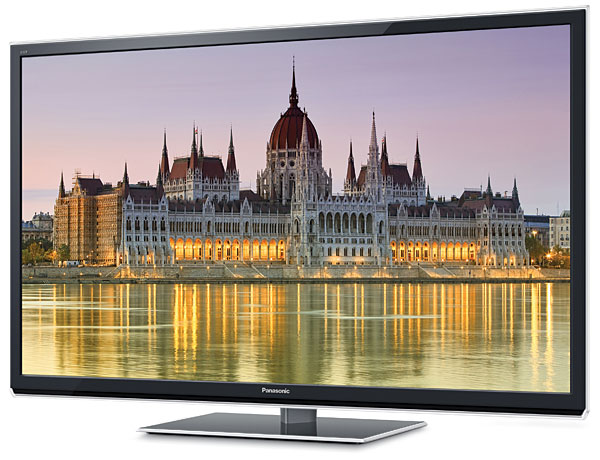Panasonic TC-P55ST50 Plasma 3D HDTV Page 2
Everything else was near golden. Only in the black level and shadow detail department does the TC-P55ST50 fall a hair short of the best. And not by much. Its measured black level was half that of last year’s TC-P55ST30. For a specification in which less is more, that’s a pretty nice improvement. The long-departed Pioneer Kuros, and a few backlit local dimming LED/LCD sets, would only look better on the darkest, lowest contrast scenes.
 The classic reference here is the opening below-decks night sequence from Master and Commander: The Far Side of the World. The black backgrounds there looked more dark gray on the Panasonic than the near jet black I’ve seen on a very few other sets—sets which, it must be said, cost a good deal more money than this one. The same goes for a few of the very darkest parts of Harry Potter and the Deathly Hallows: Part 2.
The classic reference here is the opening below-decks night sequence from Master and Commander: The Far Side of the World. The black backgrounds there looked more dark gray on the Panasonic than the near jet black I’ve seen on a very few other sets—sets which, it must be said, cost a good deal more money than this one. The same goes for a few of the very darkest parts of Harry Potter and the Deathly Hallows: Part 2.
But in scenes containing both light and dark elements, with the latter predominating, the Panasonic was hard to fault. The descent into the vaults at Gringotts bank in the same Potter film looked superb, with deep blacks and first-rate shadow detail. The night scene inside a tent in chapter nine of Hidalgo, which has tripped up lesser displays we’ve reviewed in the past, was nearly flawless.
The Panasonic’s colors were also bold and crisp, yet exceptionally natural. Flesh tones were never an issue, and greens looked right. Even before calibration, the colors left little to complain about, although they weren’t absolutely ideal. My only technical complaint, after calibration, involved the imperfect luminance levels of the individual colors—the set offers no color management system to correct for this. But the eye is remarkably tolerant of this type of deviation, and you’re unlikely to find any set today with more subjectively satisfying color.
The same was the case with the set’s resolution. It’s often said that computer animation can look good on anything, but that’s because of the control it offers the filmmakers. There’s no excuse for any shot being even slightly out of focus (unless intended), or for the lighting to be a bit off, or the color to be wrong. In live action, the best shot, drama-wise, isn’t always the best technically. So when I tell you that pristine animated films such as Kung Fu Panda 2, Puss in Boots, and How to Train Your Dragon were pin-sharp on the Panasonic (not to mention their amazing color palettes), you’ll know that the set is capable of such miracles if the source material gives it the ingredients needed to do so. Live action was not quite as jaw-dropping, but nevertheless left nothing to be desired in the sharpness department—and certainly superior to anything you’ll see short of the very best movie theaters.
And need I mention that the Panasonic offers one advantage that is inherent to plasmas but rare in LCDs—looking good anywhere in the room, off-axis or on.
3D Performance
The first questions any knowledgeable buyer wants answered about a set’s 3D performance are first, is it bright enough, and second, will I see 3D ghosting. I’ll answer the second question first. You might. I did see some obvious ghosting in the opening scenes from the animated Disney version of A Christmas Carol, and more subtly in one brief shot from Despicable Me. But most of the time I didn’t see any ghosting at all, including viewing extended stretches of the above films plus Avatar and Rio. As I said in last year’s review of Panasonic’s TC-P55ST30 (in which I spotted no ghosts), there’s no way to predict whether or not a particular piece of program material, or even a scene or two in an entire movie, will raise those unwelcome spirits. But in no way was this serious enough to be a deal breaker.
In most respects, the Panasonic’s 3D images were compelling. While its measured 3D brightness wasn’t all that high (see HT Labs Measures), only one active-glasses set I’ve reviewed produced a more subjectively dynamic picture in 3D—the far more expensive Sharp Elite. In the Panasonic’s case, this was done with a trick we’ve seen recently in other displays besides Panasonics: reproducing the 3D image with a low gamma.
Gamma determines the brightness of the picture relative to the brightness in the source. If you lower the gamma, the mid- tones become brighter; if you raise it, they become darker. If carried to extremes, low gamma can produce a flat, washed-out image. But for reasons not yet entirely clear to me, that is not always the case in 3D. In the Custom Picture mode I used here for 3D, gamma settings of 2.2 or even 2.0 produced gammas far below that level, but looked perfectly fine. The only time I wished for more punch in the Panasonic’s 3D images was on the darkest forest scenes in Avatar. They looked a little crushed.

In fact, the Panasonic’s subjective 3D brightness largely overcame my main issue with 3D on most displays: choosing between the brighter, punchier 2D picture and a darker image with enhanced depth from 3D. With this set, that conflict rarely occurred.
The icing on the 3D cake was Panasonic’s newest 3D glasses. They look a little cheap compared to the old ones (and they are cheaper!), but the main reason they impressed me is that they’ve shaved away as much excess plastic as possible, making them some of the lightest, most comfortable active 3D glasses I’ve yet worn. The only problem I had with them was that I sometimes had to cycle through their On/Off switch more than once to get them to lock onto the 3D image.
Conclusions
The hardest part of doing this review was finding something to complain about. I wasn’t very successful. With a remarkable price, superb 2D performance, and 3D that can only be bettered by spending a lot more (and often, not even then), this Panasonic is a no-brainer. When I tested three different Panasonic plasmas last year, the TC-P55ST30 was my sentimental favorite. And while we haven’t yet tested Panasonic’s premier 2012 offering, the VT50-series, if your budget won’t stretch that far, it’s hard to imagine you not being thrilled with the TC-P55ST50.














































